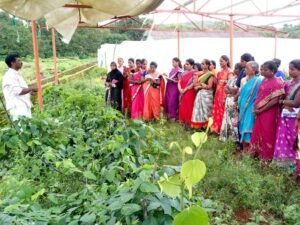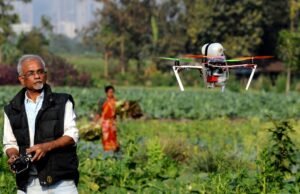The Indian government has taken an extraordinary step to take one more step towards women’s self-reliance.
The Union Cabinet led by Prime minister Shri Narendra Modi, has approved a central sector scheme to provide drones to 15,000 progressive women’s self-help groups (SHGs) with an outlay of Rs 1,261 crore.

Drones will be offered to 15,000 selected women from self-help groups for two years spanning from 2023-24 to 2025-2026. The women will be given training to use the drone as well.
The scheme allows for a holistic intervention by pooling the resources and efforts of the Department of Agriculture and Farmers Welfare (DA&FW), Department of Rural Development (DoRD) and Department of Fertilizers (DoF), Women SHGs and Major Fertilizer Companies (LFCs).
After the news broke, stocks like Droneacharya Aerial Innovation rose nearly 4 percent. According to some reports, PM Modi is going to launch the Pradhan Mantri Mahila Kishan Drone Center through a video conference. A news report also said that India is on track to finalize a deal to buy 31 MQ-9B Predator armed drones from the US in a government-to-government contract, according to sources familiar with the matter.

Objectives
Prime Minister Narendra Modi’s integration of this technology emphasizes self-reliance, women’s empowerment and agricultural innovation. The main objective of the scheme is to empower 15,000 selected women SHGs within two years by helping them with drones to provide rental services for agricultural work.
Not only this, the project will also help advance technology in agriculture will increase crop yield and reduce operation costs for the benefit of farmers.
In his Independence Day speech on August 15, Prime minister Modi announced empowering self-help groups with drone technology to harness the potential of science and technology in rural development. He also announced the Lakhpati Didi project there. What will happen with the supply of drones is that each drone will cost Rs 10 lakh, 80% of which will be borne by the center, and the rest will come from the subsidy scheme. Technology and Broadcasting Minister Anurag Singh Thakur said each woman “drone pilot” would be paid Rs 15,000 per month and her assistant Rs 10,000. They would be able to earn additional income of at least Rs one lakh per annum.
Benefits
Agricultural support
The project will help advance technology in agriculture to improve efficiency, increase crop yield, and reduce operation costs for the benefit of farmers.
The lead fertilizer companies (LFCs) will also develop the use of Nano fertilizers, such as drones. SHGs will rent out the drone services to the farmers for nanofertilizer and also for pesticide applications.
Economical support
A central financial assistance of 80 percent of the drone and accessory/ancillary charges up to a maximum of Rs 8 lakh will be provided to women self-help groups for the purchase of drones.
Cluster-level Federations of SHGs (CLFs) can raise the balance amount as loans under the National Agriculture Infrastructure Financing Facility (AIF).
Technical support
Other members or family members of SHGs with an inclination towards the repair, fitting, and mechanical work of electrical equipment will be selected by the State Rural Livelihood Mission (SRLM) to be trained as drone technician assistants. members of SHGs will be trained as drone pilots and technicians, bridging the gap between suppliers and SHGs to not only operate drones but also repair and maintain them.

Process plans of the scheme
More than 10 lakh women are associated with SHGs. The Union Cabinet informed that 500 drones will be handed over by March 2026.
A cluster of 10–15 villages will be created, and around 1,000 hectares of land will be available for each drone operation. Lead fertilizer companies (LFCs) will act as a bridge between the drone supply companies and the SHGs.
According to a Union Cabinet statement, one female SHG member aged 18 years and older will be selected for a 15-day training, of which five days of mandatory drone pilot training and an additional 10 days of operational work will be taught.
Another SHG member or even a family member will be chosen for repairing electrical items and mechanical work
Training will also be provided for agricultural purposes in the application of nutrients and pesticides. This training will be provided as a package along with the delivery of the drone.

Significance of Drones in Agriculture
The benefits that drones can bring to agriculture are undeniable. Drones cover large areas of land quickly and efficiently, allowing farmers to effectively monitor crops. Drones reduce the need for manual labor. Drones capture high-resolution images and data to provide farmers with a detailed view of their crops. spraying pesticides with Drone also makes it easier for humans.
However, most of the people associated with agriculture do not want to use drones due to concerns and a fear of losing their work. Another major issue that arises is training. Many do not want to adopt this technology for fear of not being able to operate the drone properly.
Drones need to be adopted for a wide range of tasks in the agricultural sector, including crop mapping, soil analysis, irrigation, and pest management. Apart from donating drones to women members of self-help groups, drone operation training will be imparted to the members, which will expand the use of the technology. Apart from operating the drones, the farmers can rent out the drones, which will make them more financially viable.











Comments 2